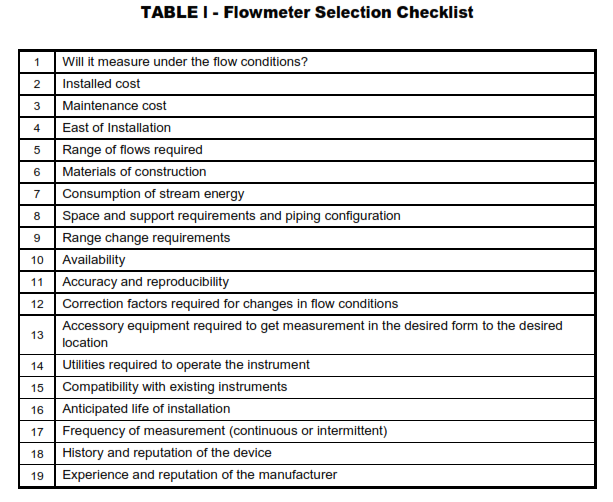Most asked and technical question asked from engineers, how to select flow meter for specific application. Here we summarize in this article for flow meter selection by application. Main keywords for this article Flow Meter selection by Application. Totalizing Flow Devices. Flow Transmitters for Viscous and Slurry Services. Flow Transmitters for High Viscosity Fluids.
Flow Meter selection by Application
Local Indication, Clean Streams
- When the installation is to indicate flow rate of process stream, and the fluid is clean, the selection may be based upon economics.
- The lowest cost devices are purge rotameters, bubblers, and sight glasses which allow for visual observation of the flow stream. Sight glass normally indicates only the presence or absence of flow, although by the addition of a hinged flapper, low accuracy (± 5 to 10 percent) flow rate indication can be obtained.
- For most industrial measurements on clean service, the choice is usually made between rotameters and various head-producing primary elements in combination with differential-pressure (D/P) indicating or transmitting devices. Rotameters are less costly in installations for pipe sizes 2 inches and smaller. Rotameters possess the desirable feature of requiring no straight pipe run, but the glass tube versions can be a safety hazard in toxic or flammable services.
- When large flow rates are to be measured, pitot tubes or elbow flowmeters have the advantages of low cost and minimal pressure drop introduced by the flow element. These advantages shall be balanced against low rangeability and accuracy. Another low cost but more accurate method of large flow rate measurement is the use of bypass rotameters around a plate in the main line. Venturi tubes and flow nozzles are utilized where accuracy and rangeability are required with low pressure drops through the sensors.
Flow Transmitters for Clean Streams
The choice is usually made between transmitting rotameters, orifice plates with D/P transmitters, and vortex flowmeters based upon piping convenience, safety, rangeability, accuracy, and cost considerations. Transmitting rotameters are more economical than D/P installations in sizes 2 inches and smaller. Vortex meters are competitive in sizes 1 to 8 inches. On installations where higher accuracy is required (± 1 percent of rate or better), specially calibrated rotameters, magnetic flowmeters, vortex meters, turbine meters are usually used.
Totalizing Flow Devices
On batch type processes, interest is in the total volume delivered and not in the changing flow rate. The most frequently installed devices for flow totalization are the various gas and liquid displacement type meters, vortex meters, and turbine meters.
These units also tend to be the most economical installations, although the use of level switches on calibrated volumetric charge tanks can be even less expensive. The accuracy of positive displacement totalizers varies substantially with the design involved, but the better units can compete in precision with the more expensive weighting systems.
Flow Transmitters for Viscous and Slurry Services
When hard to handle process streams are to be metered, moving parts, sharp edges, cavities, or other obstructions in contact with the process liquid shall be avoided and the flow path through the detector shall be streamlined. There are only a few flowmeters that satisfy all of these requirements.
- The magnetic flowmeter is used for difficult services and will measure flow streams of conductivity between 0.1 to 20 microhms/centimeter, depending upon the design.
- On low viscosity and light slurry applications, the displacement type, swirl, target, ultrasonic segmental, or eccentric elements have also been used with varying degrees of success.
- the segmental wedge flowmeter can be used successfully on low to medium viscosity liquids and liquids containing solids. The flowmeter has similarities with the orifice plate but, unlike the orifice plate, it maintains accuracy at Reynolds numbers down to 1000.
- Coriolis mass flowmeter can be applied successfully to an obstructionless design. Readings are affected by entrapped gas in liquid application.
Flow Transmitters for High Viscosity Fluids
- Highly viscous fluids can be measured with rotameters with limitations when using viscosity compensating floats.
- A laminar flow element with a D/P transmitter across the element can also be used. The viscosity shall be controlled in order to measure flow accurately.
- Gear meters can be used for fluids of viscosity upto 200 centipoises. These meters can be provided with steam or dowtherm jackets.
- Metering pumps can be used to measure high viscosity fluids or in very low flow measuring applications.
- Light slurries can be measured with flow nozzles, venturis, eccentric and segmental orifices, target meters, and magnetic flowmeters.
Flow Transmitters for Dirty Services
Turbid flows containing large solids can be measured in weirs, venturis, flumes, and flow nozzles that do not interfere with movement of the solids. Magnetic and ultrasonic meters can also be used for this application.
Flow Transmitters for Anhydrous Ammonia
Differential meters, fluidic meters, turbine and positive-displacement meters are used for anhydrous ammonia service. Turbine meters can also be used for this application.
Flow Transmitters for Highly Corrosive Fluids
Metal tube rotameters and magnetic flowmeters are available with various types of corrosion resistant liners, for example Teflon fluorocarbon resin, Penton, vitreous enamel and PVC. Some D/P transmitter manufacturers can provide all-plastic lined transmitters. Component parts made of tantalum or Hastelloy can also be used. Coriolis flowmeters are available with Hastelloy wetted parts.
Other Flowmeters
The following flowmeters may be used in special applications:
(i) Thermal flowmeters
(ii) Insertion turbine flowmeters
(iii) Swirl meters

